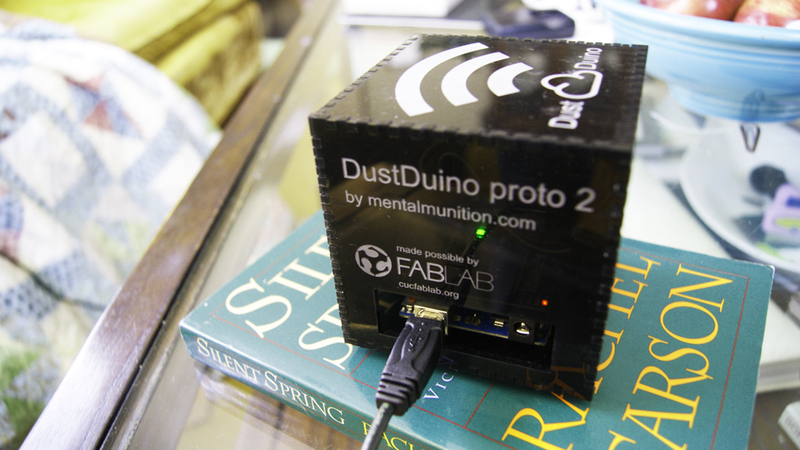
DustDuino
What is it?
DustDuino can help individuals with limited resources monitor PM10 and PM2.5 concentrations, indoors or outdoors. It uses Shinyei PPD42NS, a $15USD optical sensor that uses an LED and a lens to determine the concentration of dust in a partially closed chamber that draws in air from its surroundings. The sensor data is received by an Arduino development board and transmitted to Xively. Prototypes of DustDuino have been successfully built and used in various indoor and outdoor locations.
Ask a question about dustduino or Sign up to answer questions on this topic
What can the DustDuino Do?
From the Data Quality Research Note
Test results indicate that DustDuino provides accurate and useful information, albeit of a somewhat limited scope and under certain conditions. An academic study which compared the Shenyei particulate matter sensor to costlier models used by governments, researchers, and companies found that this low-cost sensor produced results equivalent to much more expensive ones when analyzing data at hourly intervals.
Testing with reference monitors conducted in Berkeley, California in late 2013 concluded that the results of the low-cost sensor were about equivalent to much more expensive ones when analyzing data at hourly intervals. ”Performance at 1 [hour] integration times was comparable to commercially available optical instruments costing considerably more.”
Testing in high PM2.5 environments such as the city of Xi'an, China also has shown high correlations between the Shenyei and reference monitors. By setting up a variety of monitors throughout the city, researchers were able to identify the High-technology Zone site as a potential PM2.5 hotspot with sustained high concentrations compared to the city average throughout the day.
There are still some unknowns with regard to the sensor - for example, whether it needs to be co-located with higher-quality instruments for calibration, and whether it could be used in extreme environments. There are also some limitations - the sensor may not produce high-quality information at time intervals shorter than an hour,
Photos
Why make one?
The health effects attributed to outdoor fine particulate matter (PM2.5) rank it among the risk factors with the highest health impacts in the world, accounting for over 3.2 million premature deaths annually. In October 2013, the World Health Organization announced they consider particulate matter, a major component of indoor and outdoor air pollution, as a Group 1 carcinogen along with tobacco smoke and asbestos.
Research Notes
| Title | Overview | :-------------------------:|:---------------------:| | How to Make a DustDuino | Intro, parts list, assembly, configuration | | Data Quality | A review of relevant scientific literature, limitations, and use cases | | Solar Powered Air Quality Sensor | Combining the air quality sensor with a GSM network. | | Testing a Mobile DustDuino| An experimental dustduino ride along |
How to Make One
From the DustDuino Research Note
You will need: 1. A WiFi network in your home
Arduino Uno development board
Arduino Wireless Proto Shield
Shinyei PPD-42 Dust Sensor
Sparkfun Roving Networks RN-XV WiFi module
USB type B cable (for programming the Arduino)
9V DC power supply (or a 5V USB cell phone charger along with your USB-B cable)
22AWG solid core hookup wire (M/M jumper wires can be used in a pinch)
Soldering equipment (soldering iron, solder, and soldering paste)
Arduino sketch from the DustDuino GitHub repository (zipped repo also contains background literature on the PPD-42, mass concentration algorithms, and the DustDuino logo).
Step 1: Program the WiFi module
Step 2: Hook up the Shinyei PPD-42 particulate sensor
Step 3: Set up a Xively account
Step 5: Keep everything together
Scientific Journal Articles
A distributed network of low-cost continuous reading sensors to measure spatiotemporal variations of PM2.5 in Xi'an, China; Meiling Gao, Junji Cao, Edmund Seto. January 13, 2015 PDF LINK
Field calibrations of a low-cost aerosol sensor at a regulatory monitoring site in California; DM Holstius et al. January 27, 2014.
External Tutorials
Earth Journalism Network- Civic Science & Sensors Program
News Articles
| Title | Overview | :-------------------------:|:---------------------:| | Nature | Environmental science: Pollution patrol | | Newsweek | How Civic Science Is Changing Environmentalism |
